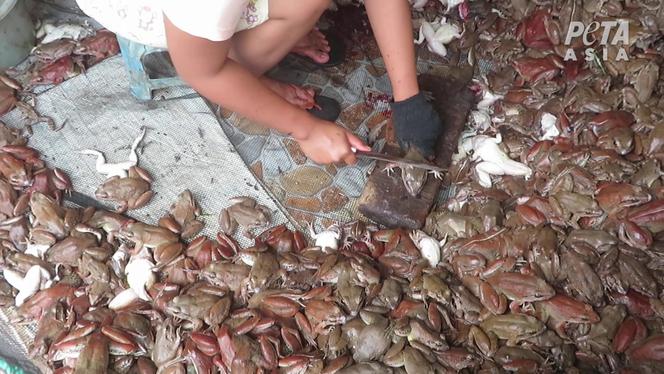


The reputation of the French as frog eaters is not just a cliché: while the consumption of frog legs remains marginal, its impact is not. Frogs are far from a strictly local product for French diners: France is the world's leading importer, and the vast majority come from Indonesia. The consumption habit affects ecosystems and causes animal suffering. Several scientific studies have already demonstrated the pressure exerted by this trade on amphibian populations in Europe and Asia.
A study published on Thursday, December 7 by People for the Ethical Treatment of Animals (PETA), and shared with Le Monde, sheds light for the first time on the conditions under which amphibians are captured and slaughtered in Indonesia, the world's leading exporter of frog legs. PETA Asia's investigators visited seven frog capture and slaughter centers in Java, Bali and Sumatra in 2023. "What you see in the footage we filmed is what was willingly shown to outside visitors," said Jason Baker, PETA's vice president of international campaigns. Some of the images were shot on hidden camera, while others were filmed with the knowledge of the centers' operators.
The scenes filmed by PETA show how the amphibians are captured in the wild – the frogs consumed are rarely bred on farms – and crammed into bags where they are left for more than two days, without any water supply, and where some die of suffocation. Live and dead frogs are sorted on the ground. Some are knocked to the ground to be killed. "These frogs are treated like objects that feel no pain. There is no consideration for their suffering," Baker said. The footage shows employees removing the skin of still-conscious frogs and severing their heads behind the ear. "Yet if the head were cut off in front of the ear, death would be quicker," Baker continued, "so frogs remain conscious for over an hour after amputation."
Amphibians are sentient beings. "Frogs are vertebrates, which have a brain similar to ours and feel pain," said Annemarie Ohler, herpetologist and professor at France's National Museum of Natural History. The suffering is further enhanced by the fact that for just over two pounds of frog legs, 20 to 50 amphibians have to be killed, not counting those who die in the process, notably in the collection bags. "Frogs breathe largely through their skin," said the scientist, "when they're crammed into bags as seen in these videos, they can't breathe. Mortality is bound to be very high."
According to the organizations Pro Wildlife et Robin des Bois, the European Union imports an average of 4,070 tons of frog legs every year (including 3,000 tons in France), which amounts to 80 to 200 million frogs depending on their size (60 to 150 million in France alone). About 80% of them come from Indonesia, 13% from Vietnam and 3.4% from Turkey.
You have 60% of this article left to read. The rest is for subscribers only.
